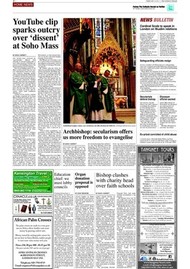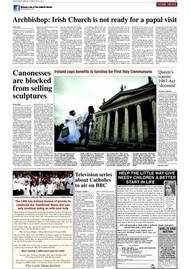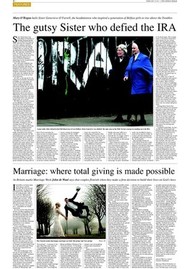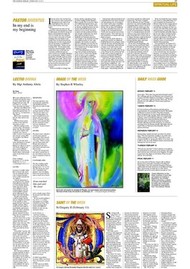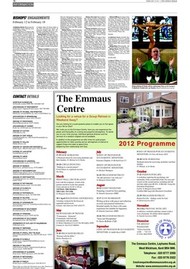Page 15, 10th February 2012
Page 15
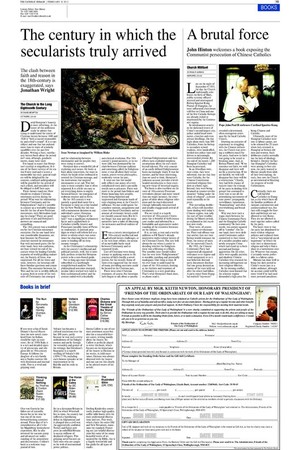
Report an error
Noticed an error on this page?If you've noticed an error in this article please click here to report it.
Tags
Share
Related articles
Wales Was Born In The Monasteries
Latin America: A Crucible Of Modern Christianity
What We Can Learn From The Pentecostals
Dilemma And Love Of A
The Reluctant Prophet
The century in which the secularists truly arrived
The clash between faith and reason in the 18th-century is exaggerated, says Jonathan Wright
The Church in the Long Eighteenth Century
BY DAVID HEMPTON I B TAURIS, £24.50
David Hempton’s honesty is most refreshing. At the outset of this ambitious study he admits that trying to understand the course of Christian history between 1680 and 1820 is “both a sacred responsibility and a fool’s errand”. It is a vast subject and one that has endured more than its share of scholarly squabbles over the past few decades. Writing a short, satisfactory history book about the period isn’t easy, although, goodness knows, many have tried.
I’m happy to report that Hempton’s attempt is magnificent. It is one of the finest surveys of the era that I have read and it scores a memorable hat-trick: general readers will be delighted by the contents, confused undergraduates will be grateful for the arrival of such a book, and specialists will be obliged to doff their caps. Three themes stand out. How should we evaluate Christian missionary activity during the period? What was the relationship between Christianity and the Enlightenment? And is it possible to conjure up a workable explanation for the rise of new Protestant movements, with Methodism leading the charge? These are good questions to ask and Hempton’s answers are nuanced and compelling.
The 18th century was a muddled era for the Christian missionary enterprise. On the one hand there was considerable dynamism, not least because the Protestant churches entered the missionary fray with increased gusto. On the other hand, there was confusion, not least toward the end of the century when the leading Catholic exponent of world-girdling endeavour, the Society of Jesus, was suppressed. For all the twists and turns, however, the historian still faces familiar questions and conundrums. The encounter between the West and the rest is terribly difficult to grasp, both in terms of the varieties of Christianity that emerged and the relationship between missionaries and the peoples they were trying to convert.
Hempton does a wonderful job of exploring such issues. He looks at fears about syncretism, the ways in which the locals either embraced or resisted the Christian message, and the motivations that inspired missionaries to set sail. This last topic is more complex than is often supposed. It is a little too easy to put everything down to mighty historical forces: the emergence of seaborne empires and so forth. By the 18th century it was patently a good deal easier for a European to jump on a ship headed for the New World, but this was still a momentous decision in any individual’s career. Hempton suggests that a “religion of the heart” was a significant explanatory factor and it applied both to Catholics (chiefly Jesuits) and Protestants (notably those of Pietistic tendencies). A spiritual paradigm in which self-reform led to a desire to reform others was sometimes the clinching factor when it came to heading off on risky oceanic voyages.
As for Christianity’s relationship with the century’s intellectual and political currents, well, this is similarly perilous terrain but Hempton proves to be a sure-footed guide. Not so long ago most historians subscribed to a satisfyingly straightforward analysis. New philosophical nostrums emerged, secular rulers worked very hard to limit ecclesiastical power and the century ended with a decidedly
anti-clerical revolution. The 18th century’s grand narrative, or so we were told, was dominated by the clash between Christian tradition and something called the Enlightenment; it was all about faith versus reason, priests versus philusuphes, modernity versus the past.
It turns out that this model only reflects one aspect of a very complicated story and it can easily morph into a caricature. There was more to the period than Diderot and Hume launching their assaults, Jesuits being banished and suppressed and European heads of state chipping away at the Church’s influence. No one could ignore the countless tensions, antagonisms and crises that faced Christianity and no amount of revisionist history could (or should) conceal them. But let’s not forget that neat and tidy metanarratives have a habit of obscuring the intricacies and lived realities of the past.
Even a cursory investigation of 18th-century intellectual and cultural history challenges, or at the very least refines, the notion of an inevitable battle royal between Christianity and its supposed rivals.
Lots of Christians were doing science or applying reason to the practice of faith (hardly a novel pursuit, for the record). Some of them even suggested that the roots of many prevailing nostrums could be located in the Christian past. There were other Christian responses, of course, but historians have begun to talk about a specific Christian Enlightenment and their efforts have exploded simplistic assumptions about the era’s intellectual odyssey. The very concept of an easily defined Enlightenment looks increasingly shaky. It was far messier, and far more interesting, than we used to think. Hempton’s judicious account provides a levelheaded introduction to these exciting new vistas of historical inquiry. The book is also excellent on the roots of 18th-century Protestant revivalism (deeper and more varied than one might assume), the emergence of ideas about religious toleration and the much-discussed (though habitually misconstrued and usually exaggerated) arrival of secularism.
The net result is a superb overview of 18th-century Christianity that is brimful of well-chosen case studies and informed by a formidable and appreciative understanding of the extensive literature on the subject.
It is, in sum, a treat and a worthy addition to I B Tauris’s already impressive multi-volume history of the Christian Church. The jury will always be out when it comes to deciding whether the Enlightenment was a blessing or a blight. The sensible juror should realise that the very term “Enlightenment” is mutable, puzzling and potentially inadequate. One thing is clear. If we ever hope to understand the chaos of the 18th-century, looking at the rhythms and responses of Christianity is a very good idea. That’s what Hempton’s book does, so please read it.
blog comments powered by Disqus



